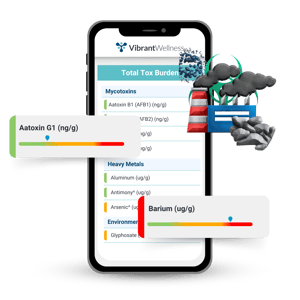Saliva vs. Urine Hormone Testing: What’s the Difference?
This article examines two advanced lab tests from Vibrant Wellness: the Salivary Hormones Test and the Hormone Zoomer. Each offers valuable insights on its own, but in tandem, they provide a comprehensive view of hormone production, metabolism, and clearance.
Table of Contents
Why Collection Method Matters

Hormonal imbalance can present in subtle, non-specific ways: fatigue, weight gain, sleep disturbances, anxiety, cycle irregularity, and more. These symptoms are easy to overlook or misattribute, especially when standard labs come back within normal range.
Traditional hormone testing offers a narrow view. It often captures total hormone levels at one moment in time, but doesn’t reflect how hormones behave in the body. It won’t show:
-
How much hormone is actually available to cells
-
When levels rise or fall throughout the day
-
How hormones are metabolized or eliminated
-
Whether outside compounds are interfering with hormone activity
For a clearer picture, the collection method matters. Saliva testing reflects active and available hormones in the moment. Urine testing reveals how hormones are processed, converted, and cleared.
Each captures a different dimension of hormone activity. Together, they offer a more complete view of production, rhythm, and metabolism, key context when symptoms persist without an obvious cause.
Salivary Hormone Testing: Real-Time, Bioavailable Hormones
The Salivary Hormones Test measures the free (unbound) fraction of steroid hormones that have diffused into the saliva and are available for tissue uptake. Because this test captures hormones in their biologically active form, it provides a real-time picture of endocrine activity.
 Saliva is collected four times across a 24-hour period, making this test especially valuable for evaluating:
Saliva is collected four times across a 24-hour period, making this test especially valuable for evaluating:
-
Cortisol awakening response and daily rhythm
-
Melatonin levels at night
-
Estradiol, progesterone, and testosterone fluctuations across the menstrual cycle or andropause
This method is non-invasive, stress-free, and suitable for serial sampling—ideal for tracking dynamic changes in hormone output over a 24-hour period.
Urinary Hormone Testing: Metabolized Hormones and Detox Pathways
The Hormone Zoomer is a four-sample urine test that evaluates conjugated and metabolized hormones, offering a metabolic map of how hormones are metabolized through enzymatic pathways involved in detoxification and clearance.
 It measures both parent hormones and their phase I and phase II metabolites, including:
It measures both parent hormones and their phase I and phase II metabolites, including:
-
Estrogen detoxification pathways (2-OH, 4-OH, 16-OH)
-
Androgen metabolites (e.g., DHT)
-
Progesterone and cortisol breakdown products
-
Methylation capacity and COMT activity
This test is ideal for assessing:
-
Hormone dominance or poor clearance
-
Carcinogenic vs. protective estrogen metabolism
-
The impact of liver detoxification or gut reabsorption
-
Overall hormone burden and excretion efficiency
Because it reflects cumulative hormone metabolism over several hours, the Hormone Zoomer offers deep insight into systemic patterns not captured in a moment-in-time snapshot.
Advantages and Limitations at a Glance

While both saliva and urine hormone tests offer valuable clinical insight, they differ in what they measure, how they’re collected, and the types of information they reveal.
The Vibrant Salivary Hormones panel measures free, bioavailable hormones using four timepoints across a 24-hour period. This allows for precise tracking of diurnal hormone patterns, particularly cortisol and melatonin.
The primary strength of saliva testing lies in its ability to assess real-time bioavailability and diurnal hormone fluctuations. However, because it focuses exclusively on active hormones, it does not provide insight into hormone metabolism or excretion.
On the other hand, the Hormone Zoomer measures conjugated and metabolized hormones through a structured four-sample liquid urine collection across one day, offering a broader view of how the body processes, metabolizes, and eliminates hormonal compounds.
Samples are collected four times across a 24-hour period: upon waking, two hours later, before dinner, and before bed. The Hormone Zoomer goes beyond other urinary hormone tests by providing rich data on endocrine disruptors, metabolite ratios, and overall hormone clearance efficiency.
While urine testing reflects hormone metabolism over time, it does not capture moment-to-moment fluctuations or free hormone availability.
Used together, they offer a fuller, clinically actionable picture of both hormone availability and how the body processes and eliminates those hormones.
Choosing the Optimal Approach
Each method provides distinct, non-overlapping data. Saliva reflects how much hormone is free, unbound, and available to tissues at specific times of day. Urine shows how hormones are metabolized, conjugated, and excreted—and whether any metabolic patterns or external exposures are affecting that process.
When used together, they can help answer key clinical questions:
-
Is fatigue due to low cortisol production or poor clearance of active metabolites?
-
Is estrogen dominance caused by excess production or impaired detoxification?
-
Are testosterone and DHEA levels low due to underproduction, or conversion into estrogen or DHT through elevated aromatase or 5α-reductase activity?
In short: saliva testing captures the hormonal signal at the tissue level, while urine testing measures how that signal is metabolized and excreted.
When to Use Both Tests in Practice
Using saliva and urine hormone testing together is especially helpful when symptoms suggest a hormonal imbalance, but the source—or pattern—isn’t clear.
Here are common scenarios where the dual approach offers deeper insight:
Menstrual Irregularity, PMS, or Perimenopausal Symptoms

Fluctuating estrogen and progesterone levels may look “normal” in serum but show distinct patterns in salivary cortisol or urinary metabolites. Pairing both tests helps identify hormone dominance, clearance issues, or adrenal stress that may be compounding symptoms.
Explore dietary strategies that support hormonal balance in later reproductive years in Nutrition Strategies to Reverse Insulin Resistance in Menopause.Suspected Adrenal Dysfunction or Burnout
Salivary testing captures diurnal cortisol patterns and cortisol awakening response. Urinary testing shows how cortisol is being metabolized and whether cortisone-cortisol balance points to HPA axis disruption.
Sleep Disorders or Disrupted Circadian Rhythms
When melatonin or cortisol rhythms are off, salivary testing can confirm mistimed secretion. Urinary metabolites help clarify whether those hormones are being properly converted or excreted.
Hormone-Sensitive Cancers or Estrogen Dominance
Estrogen metabolism pathways matter here. Urine testing identifies 2-OH vs. 4-OH vs. 16-OH pathways and methylation status. Saliva adds real-time insight into circulating estradiol and progesterone balance.
Patients on BHRT Requiring Dosage Monitoring and Metabolism Analysis
Saliva reflects current bioavailable hormone levels, while urine shows how the body is processing those hormones. This helps tailor HRT regimens with greater precision.
Poor Results From Hormone Therapy Without Clear Explanation
If symptoms persist despite lab-normal hormone levels, combined testing can uncover hidden issues—such as high tissue uptake, poor clearance, or interference from environmental toxins.
Complementary Tests For Deeper Insights
Gut Zoomer
 Estrogen metabolism is closely tied to gut health. The Gut Zoomer assesses microbial imbalances and levels of β-glucuronidase, an enzyme that can slow estrogen clearance and promote recirculation. It also screens for pathogens and dysbiosis that may affect adrenal function or contribute to systemic inflammation.
Estrogen metabolism is closely tied to gut health. The Gut Zoomer assesses microbial imbalances and levels of β-glucuronidase, an enzyme that can slow estrogen clearance and promote recirculation. It also screens for pathogens and dysbiosis that may affect adrenal function or contribute to systemic inflammation.Neural Zoomer Plus
Autoimmunity affecting the brain or nervous system can interfere with hormone regulation at the hypothalamic or pituitary level. The Neural Zoomer Plus evaluates antibodies linked to neuroinflammation, providing valuable insight when cognitive or mood symptoms overlap with hormonal issues.
Learn more in Research Spotlight: Novel Multiplex Testing for Early Detection of Autoimmunity.
Total Tox Burden

Micronutrient Panel
The Bottom Line
Saliva and urine hormone testing each offer distinct insights into endocrine function. Saliva captures real-time, bioavailable hormone levels, ideal for evaluating circadian patterns and active hormone signaling. Urine reveals how hormones are metabolized, excreted, and influenced by endocrine-disrupting compounds. Together, they uncover patterns that single-method testing can miss, especially when symptoms defy simple explanations.
To better understand when and how to use serum, saliva, and urine testing, especially in the context of HRT, cortisol mapping, or metabolite assessment, download our Quick Comparison Guide: Serum, Saliva & Urine Hormone Testing for a side-by-side view of sample types, use cases, and limitations.
The general wellness test intended uses relate to sustaining or offering general improvement to functions associated with a general state of health while making reference to diseases or conditions. This test has been laboratory developed and its performance characteristics determined by Vibrant America LLC and Vibrant Genomics, a CLIA-certified and CAP-accredited laboratory performing the test. The lab tests referenced have not been cleared or approved by the U.S. Food and Drug Administration (FDA). Although FDA does not currently clear or approve laboratory-developed tests in the U.S., certification of the laboratory is required under CLIA to ensure the quality and validity of the tests
 By
By




